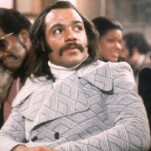YA cliché? While the description of Last Dragonslayer sounds heavily clichéd, with a teenage girl given huge responsibility and becoming the Chosen One focus of a world-changing prophecy, the actual book doesn’t feel much like modern YA. It reads much more like a Diana Wynne Jones book, with the protagonist as the center of a screwball comedy in which everything is constantly falling apart in a comedically oversized way. Where the current trend in YA is toward Hunger Games grimness and Twilight angst, Dragonslayer is more of a wry humor book that plays on familiar fantasy tropes, while drumming up the drama to a high pitch. It isn’t exactly a parody, but it doesn’t play its genre trappings straight, either. But like a Jones book, it does eventually come down to an authentically dramatic and heartfelt moment.
Bad sign: “‘Welcome to Kazam,’ I said, stuffing the envelope into my bag, ‘where unimaginable horrors share the day with moments of confusing perplexity and utter randomness. To call it a madhouse would insult even the maddest of madhouses.’” That’s how Jennifer greets 12-year-old foundling apprentice Horton “Tiger” Prawns, whom she’s saddled with only 14 pages into the book. Tiger serves as the outsider character and audience surrogate who gives Jennifer an excuse to explain Kazam’s history, introduce various other characters, and vocalize her thoughts. It’s a trite setup, especially since Tiger is around a lot but doesn’t do much of importance except prove his precociousness; he feels like a little Cousin Oliver, except that he arrives at the beginning of the series. Also, his name is Tiger Prawns; that and Jennifer’s florid greeting are both clear foreshadowings about Dragonslayer’s overall silly tone.
Good sign: “I thought all mankind gravitated toward things that are shiny. I’m not saying that’s necessarily a bad thing, but when it comes to species development, it could be limiting.” This is one of the many casual observations the last dragon, Maltcassion, makes to Jennifer when she comes to talk to him about the whole slaying issue. In keeping with the book’s tone, he talks a lot, changes subjects often, and never gives her a chance to find her feet or make a solid decision, but he’s wry and entertaining, and comes across as charmingly inhuman. He’s one of the highlights of the book, particularly in the way Fforde puts him beyond human understanding and yet capable of empathy. All of which helps drive the book’s central confusion over why Jennifer would choose to kill him, regardless of what the prophesies say.
Young-adult appropriate? If anything, Fforde’s first foray into young-adult writing may read as a little young, closer to a mid-grade book. The prose is simple, the mood is light, and there’s no sex or violence or dry adult concerns to wrestle with. On the flip side, though, the book doesn’t particularly speak to teenagers’ place in life or in the world, in spite of the teenage protagonist. While many YA books address teen themes through situational metaphor, and it’s perhaps possible to wring a little teenager-appropriate drama out of Jennifer’s confusion, frustration, and changing place in the world, most young adults aren’t likely to see themselves in this simply drawn character who’s running around juggling her conflicting duties to cranky wizards, a dimwitted but smug king, a long tradition of magically enabled dragonslayers, and a noble dragon.
Old-adult appropriate? Adult readers who love Jones’ lighter work, Terry Pratchett’s earliest books, or Fforde’s work in general might engage with Last Dragonslayer, though in the latter case, it depends strongly on why they gravitate to Fforde. His Thursday Next books (The Eyre Affair and its six sequels to date) and the Nursery Crimes books (The Big Over Easy and The Fourth Bear) trade heavily on literary reference and absurdist comedy in a way that rewards prolific readers and literature buffs. Last Dragonslayer is a much simpler affair. That said, it does quickly sketch out an intriguing and unusual fantasy world, one built firmly on modern society with a magical twist. Cars, plumbing, and giant war machines exist alongside a monocracy, magical spells, and mythical beasts. Fforde’s fresh take on the details of what could have been a rote world might be enough to bring in fantasy fans of a variety of ages.
Could use less: Sudden reversals. Last Dragonslayer has a couple of prominent plot developments that come out of nowhere, as characters abruptly choose to do the exact opposite of what they’ve been stridently advocating all along. Both cases are necessary for the plot to proceed, but both cases also read suspiciously as though the characters alter course because they know they need to, so the plot can proceed.
Could use more: Valium. Fforde’s books often proceed at hyperspeed, with the characters careening between events, and never fully getting their bearings. Dragonslayer fits the bill; it’s clearly trying to mine humor from the screwball pace and tension from the way some new demand or problem assaults Jennifer every few pages, such that she’s never allowed to get her bearings. But the speed sometimes seems forced—as when Jennifer takes an arduous journey to meet Maltcassion, and he almost instantly thanks her for coming and dismisses her, and she goes meekly, without asking any meaningful questions. The approach often makes her seem too passive and not enough like a character, let alone a protagonist; she’s perpetually reactive rather than proactive. It makes for a funny book, but not a particularly solid or memorable one.
For fans of: Pratchett’s The Colour Of Magic, Jones’ House Of Many Ways or Enchanted Glass, parents who love the Tuesday Next books and want to ease their kids into them with a fun book to read aloud.







































